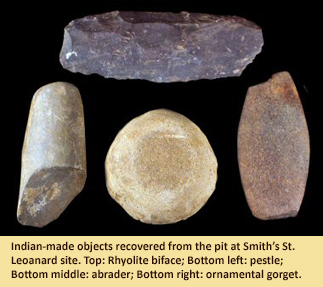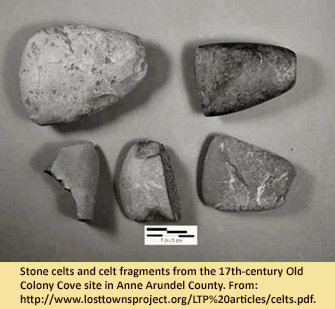A Colonial Collection of Native American Artifacts
December 2009
By Sami Allen, MAC Lab Public Archaeology Asst.
 In 1999, archaeologists at JPPM stumbled upon a pit at the Smith's St. Leonard site. It contained a variety of mid-18th-century artifacts, such as animal bone, pottery, and a large iron fireback. Yet arguably, the most intriguing objects were four stone Native American artifacts that appear to have been deliberately discarded. They consisted of an ornament known as a gorget, a pestle, a rhyolite knife, and a smoothed, flat-based, semi-spherical object, possibly an abrader. To understand this mysterious find, archaeologists must ask: Why are these objects here? Did the English occupants of the site use them? Or were they collected out of curiosity? The presence of Native American objects amongst English artifacts can help us better understand the relationships between these two cultures.
In 1999, archaeologists at JPPM stumbled upon a pit at the Smith's St. Leonard site. It contained a variety of mid-18th-century artifacts, such as animal bone, pottery, and a large iron fireback. Yet arguably, the most intriguing objects were four stone Native American artifacts that appear to have been deliberately discarded. They consisted of an ornament known as a gorget, a pestle, a rhyolite knife, and a smoothed, flat-based, semi-spherical object, possibly an abrader. To understand this mysterious find, archaeologists must ask: Why are these objects here? Did the English occupants of the site use them? Or were they collected out of curiosity? The presence of Native American objects amongst English artifacts can help us better understand the relationships between these two cultures.
Native-made artifacts arrived at colonial Maryland sites through various ways. In the 17th century, the primary mechanism was trade. Indian pots have been found on the sites of English settlers, and Native baskets and mats appear in probate inventories. Native Americans were employed by the English  to manufacture canoes, and shell beads were used as currency by Indians and colonists alike. There is even evidence that the English may have occasionally used Indian stone axes.
to manufacture canoes, and shell beads were used as currency by Indians and colonists alike. There is even evidence that the English may have occasionally used Indian stone axes.
But by the 18th century, most Indians were gone from Southern Maryland, and there were few opportunities for locals to acquire Native goods through trade. Instead, the colonists began to view Indian artifacts as novelties and collector’s items. This had long been true in Europe, but 17th-century Marylanders had more pressing concerns. Then in the 18th century, as Indian populations declined and Enlightenment ideas about the natural world spread, curiosity about Native Americans became more common.
 This can be seen on many colonial sites, where Indian artifacts have been found in contexts that suggest they were simple curios. At the Smith’s St. Leonard site, several of the stone tools in the pit had residue from marine organisms, indicating that they were found on a beach. They were probably collected by someone interested in the past, but eventually were thrown away with other household trash, possibly by someone who did not share the same interest.
This can be seen on many colonial sites, where Indian artifacts have been found in contexts that suggest they were simple curios. At the Smith’s St. Leonard site, several of the stone tools in the pit had residue from marine organisms, indicating that they were found on a beach. They were probably collected by someone interested in the past, but eventually were thrown away with other household trash, possibly by someone who did not share the same interest.
American colonial identity was shaped by English interactions with Indians. In the 17th century, that interaction occurred in person, and Native material culture was a significant part of English daily life. However in 18th-century Southern Maryland, Indian artifacts were viewed as curios of a disappeared past. Ironically, someone at the Smith's St. Leonard site was collecting artifacts on a property that 250 years later became the Maryland State Museum of Archaeology. The past is indeed prologue!
| References |
|
| Feest, Christian F. |
| 1995 |
The Collecting of American Indian Artifacts, In America in European Consciousness. The University of North Carolina Press: Chapel Hill. |
|
| King, Julia A.; Chaney, Edward E. |
| 2004 |
Did the Chesapeake English Have a Contact Period?, In Indian and European Contact in Context. University Press of Florida, Gainesville. |
|
| Luckenbach, Al; Gadsby, David |
| 2004 |
Native American Stone Celts From Colonial Contexts in the 17th Century Settlement of Providence, Maryland. Maryland Archeology 40(2):1-7. |
|